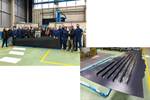New Clean Aviation projects to facilitate highly efficient aircraft by 2035
Clean Aviation, approved for €380 million to advance eight topics revolving around new aircraft concepts and propulsion architectures, reveals project focuses and partners.
Share
Read Next
The Governing Board (GB) of the Clean Aviation Joint Undertaking (Brussel, Belgium) has approved €380 million, including €152 million in EU funding, for an additional eight projects accelerating aviation’s trajectory towards climate neutrality in support of the European Green Deal.
These projects in the field of new aircraft concepts and innovative propulsion architectures, mentioned below, will complement those funded under Clean Aviation’s first call for proposals. They will help prepare all of the necessary elements for ground and flight test activities starting in 2026. According to Clean Aviation, activities proposed will exploit the maximum potential of composite materials for significant weight reduction opportunities. Overall, projects under this second call for proposals seek to help reduce net emissions of greenhouse gases for commercial air travel by no less than 30% compared to the best aircraft models available today.
“Pulling together the best talent and capabilities from the private and public sectors is key in the interest of bolstering European innovation,” Sabine Klauke, co-chair of the GB, CTO, Airbus, says. “Collectively, we are driving the world towards cleaner skies and a more sustainable future.”
The 8 projects cover topics elaborated from the Clean Aviation Strategic Research and Innovation Agenda (SRIA) built around three thrusts:
- €86 million to EU funding dedicated to hydrogen-powered aircraft;
- €33 million to EU funding for hybrid-electric regional aircraft;
- €33 million to EU funding for short and medium range aircraft.
A further €0.75 million is dedicated to impact monitoring of EU aviation research and innovation.
The following projects and partners are detailed below:
Hybrid Electric
- HERFUSE (Hybrid-Electric Regional Fuselage & Empennages): Leonardo
- ODE4HERA (Open Digital Environment for Hybrid-Electric Regional Architectures): DLR – German Aerospace Center
Ultra-Efficient/Short-Medium Range
- COMPANION (Common Platform and Advanced Instrumentation Readiness for Ultra Efficient Propulsion): Airbus
- AWATAR (Advanced Wing Maturation and Integration: ONERA
Hydrogen-Powered Aircraft
- TROPHY (Technological Research on Propulsion by Hydrogen): Safran
- FAME (Fuel Cell Propulsion System for Aircraft Megawatt Engines): Airbus
- HEROPS (Hydrogen-Electric Zero Emission Propulsion System): MTU Aero Engines AG
Support Action
- CLAIM (Clean Aviation Support for Impact Monitoring): DLR
The projects’ official launch is still subject to legal redress and to successful completion of grant preparation targeted for completion by the end of 2023.
Related Content
-
Plant tour: Albany Engineered Composites, Rochester, N.H., U.S.
Efficient, high-quality, well-controlled composites manufacturing at volume is the mantra for this 3D weaving specialist.
-
PEEK vs. PEKK vs. PAEK and continuous compression molding
Suppliers of thermoplastics and carbon fiber chime in regarding PEEK vs. PEKK, and now PAEK, as well as in-situ consolidation — the supply chain for thermoplastic tape composites continues to evolve.
-
Manufacturing the MFFD thermoplastic composite fuselage
Demonstrator’s upper, lower shells and assembly prove materials and new processes for lighter, cheaper and more sustainable high-rate future aircraft.

















